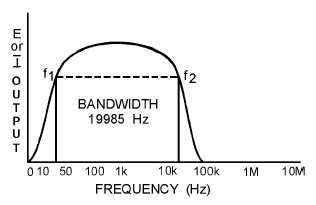2-3
Figure 2-1.—Frequency response curve of audio amplifier.
Notice in the figure that the lower frequency limit is labeled f1 and the upper frequency limit is
labeled f2. Note also the portion inside the frequency-response curve marked "BANDWIDTH." You may
be wondering just what a "bandwidth" is.
BANDWIDTH OF AN AMPLIFIER
The bandwidth represents the amount or "width" of frequencies, or the "band of frequencies," that
the amplifier is MOST effective in amplifying. However, the bandwidth is NOT the same as the band of
frequencies that is amplified. The bandwidth (BW) of an amplifier is the difference between the
frequency limits of the amplifier. For example, the band of frequencies for an amplifier may be from 10
kilohertz (10 kHz) to 30 kilohertz (30 kHz). In this case, the bandwidth would be 20 kilohertz (20 kHz).
As another example, if an amplifier is designed to amplify frequencies between 15 hertz (15 Hz) and 20
kilohertz (20 kHz), the bandwidth will be equal to 20 kilohertz minus 15 hertz or 19,985 hertz (19,985
Hz). This is shown in figure 2-1.
Mathematically:
You should notice on the figure that the frequency-response curve shows output voltage (or current)
against frequency. The lower and upper frequency limits (f1 and f2) are also known as HALF-POWER
POINTS. The half-power points are the points at which the output voltage (or current) is 70.7 percent of
the maximum output voltage (or current). Any frequency that produces less than 70.7 percent of the
maximum output voltage (or current) is outside the bandwidth and, in most cases, is not considered a
useable output of the amplifier.
The reason these points are called "half-power points" is that the true output power will be half (50
percent) of the maximum true output power when the output voltage (or current) is 70.7 percent of the
maximum output voltage (or current), as shown below. (All calculations are rounded off to two decimal
places.)
As you learned in NEETS, Module 2, in an a.c. circuit true power is calculated using the resistance
(R) of the circuit, NOT the impedance (Z). If the circuit produces a maximum output voltage of 10 volts
across a 50-ohm load, then:



